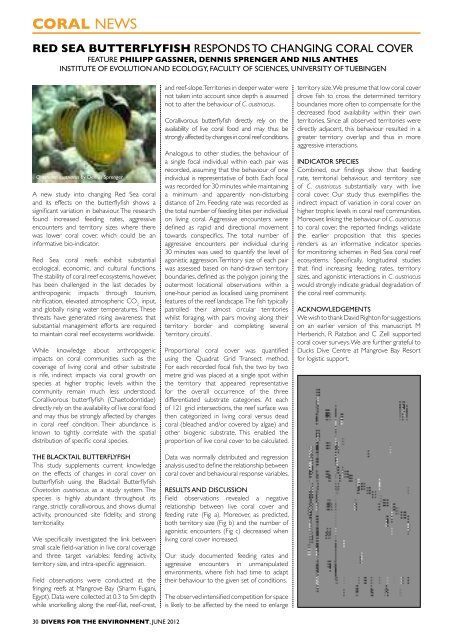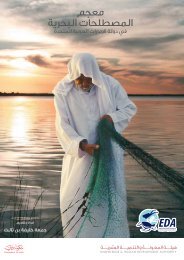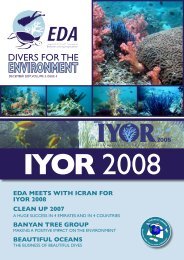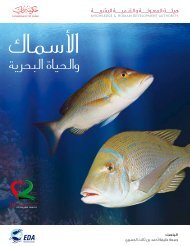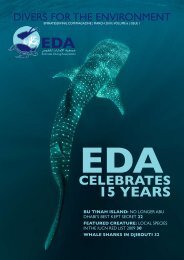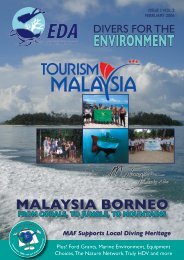Download - Emirates Diving Association
Download - Emirates Diving Association
Download - Emirates Diving Association
You also want an ePaper? Increase the reach of your titles
YUMPU automatically turns print PDFs into web optimized ePapers that Google loves.
CORAL NEWS<br />
Red Sea bUTTERFLYFISH responds TO changing coral cover<br />
feature Philipp Gassner, Dennis Sprenger and Nils Anthes<br />
Institute of Evolution and Ecology, FACULTY of Sciences, University of Tuebingen<br />
3RD PUNTA SAYULITA SURF CONTEST<br />
A WINNER FOR REEF CHECK<br />
REEF CHECK<br />
Chaetodon austriacus by Dennis Sprenger<br />
A new study into changing Red Sea coral<br />
and its effects on the butterflyfish shows a<br />
significant variation in behaviour. The research<br />
found increased feeding rates, aggressive<br />
encounters and territory sizes where there<br />
was lower coral cover, which could be an<br />
informative bio-indicator.<br />
Red Sea coral reefs exhibit substantial<br />
ecological, economic, and cultural functions.<br />
The stability of coral reef ecosystems, however,<br />
has been challenged in the last decades by<br />
anthropogenic impacts through tourism,<br />
nitrification, elevated atmospheric CO 2<br />
input,<br />
and globally rising water temperatures. These<br />
threats have generated rising awareness that<br />
substantial management efforts are required<br />
to maintain coral reef ecosystems worldwide.<br />
While knowledge about anthropogenic<br />
impacts on coral communities such as the<br />
coverage of living coral and other substrate<br />
is rife, indirect impacts via coral growth on<br />
species at higher trophic levels within the<br />
community remain much less understood.<br />
Corallivorous butterflyfish (Chaetodontidae)<br />
directly rely on the availability of live coral food<br />
and may thus be strongly affected by changes<br />
in coral reef condition. Their abundance is<br />
known to tightly correlate with the spatial<br />
distribution of specific coral species.<br />
The blacktail butterflyfish<br />
This study supplements current knowledge<br />
on the effects of changes in coral cover on<br />
butterflyfish using the Blacktail Butterflyfish<br />
Chaetodon austriacus as a study system. The<br />
species is highly abundant throughout its<br />
range, strictly corallivorous, and shows diurnal<br />
activity, pronounced site fidelity, and strong<br />
territoriality.<br />
We specifically investigated the link between<br />
small scale field-variation in live coral coverage<br />
and three target variables: feeding activity,<br />
territory size, and intra-specific aggression.<br />
Field observations were conducted at the<br />
fringing reefs at Mangrove Bay (Sharm Fugani,<br />
Egypt). Data were collected at 0.3 to 5m depth<br />
while snorkelling along the reef-flat, reef-crest,<br />
and reef-slope. Territories in deeper water were<br />
not taken into account since depth is assumed<br />
not to alter the behaviour of C. austriacus.<br />
Corallivorous butterflyfish directly rely on the<br />
availability of live coral food and may thus be<br />
strongly affected by changes in coral reef conditions.<br />
Analogous to other studies, the behaviour of<br />
a single focal individual within each pair was<br />
recorded, assuming that the behaviour of one<br />
individual is representative of both. Each focal<br />
was recorded for 30 minutes while maintaining<br />
a minimum and apparently non-disturbing<br />
distance of 2m. Feeding rate was recorded as<br />
the total number of feeding bites per individual<br />
on living coral. Aggressive encounters were<br />
defined as rapid and directional movement<br />
towards conspecifics. The total number of<br />
aggressive encounters per individual during<br />
30 minutes was used to quantify the level of<br />
agonistic aggression. Territory size of each pair<br />
was assessed based on hand-drawn territory<br />
boundaries, defined as the polygon joining the<br />
outermost locational observations within a<br />
one-hour period as localised using prominent<br />
features of the reef landscape. The fish typically<br />
patrolled their almost circular territories<br />
whilst foraging, with pairs moving along their<br />
territory border and completing several<br />
‘territory circuits’.<br />
Proportional coral cover was quantified<br />
using the Quadrat Grid Transect method.<br />
For each recorded focal fish, the two by two<br />
metre grid was placed at a single spot within<br />
the territory that appeared representative<br />
for the overall occurrence of the three<br />
differentiated substrate categories. At each<br />
of 121 grid intersections, the reef surface was<br />
then categorized in living coral versus dead<br />
coral (bleached and/or covered by algae) and<br />
other biogenic substrate. This enabled the<br />
proportion of live coral cover to be calculated.<br />
Data was normally distributed and regression<br />
analysis used to define the relationship between<br />
coral cover and behavioural response variables.<br />
Results and discussion<br />
Field observations revealed a negative<br />
relationship between live coral cover and<br />
feeding rate (Fig a). Moreover, as predicted,<br />
both territory size (Fig b) and the number of<br />
agonistic encounters (Fig c) decreased when<br />
living coral cover increased.<br />
Our study documented feeding rates and<br />
aggressive encounters in unmanipulated<br />
environments, where fish had time to adapt<br />
their behaviour to the given set of conditions.<br />
The observed intensified competition for space<br />
is likely to be affected by the need to enlarge<br />
territory size. We presume that low coral cover<br />
drove fish to cross the determined territory<br />
boundaries more often to compensate for the<br />
decreased food availability within their own<br />
territories. Since all observed territories were<br />
directly adjacent, this behaviour resulted in a<br />
greater territory overlap and thus in more<br />
aggressive interactions.<br />
Indicator species<br />
Combined, our findings show that feeding<br />
rate, territorial behaviour, and territory size<br />
of C. austriacus substantially vary with live<br />
coral cover. Our study thus exemplifies the<br />
indirect impact of variation in coral cover on<br />
higher trophic levels in coral reef communities.<br />
Moreover, linking the behaviour of C. austriacus<br />
to coral cover, the reported findings validate<br />
the earlier proposition that this species<br />
renders as an informative indicator species<br />
for monitoring schemes in Red Sea coral reef<br />
ecosystems. Specifically, longitudinal studies<br />
that find increasing feeding rates, territory<br />
sizes, and agonistic interactions in C. austriacus<br />
would strongly indicate gradual degradation of<br />
the coral reef community.<br />
ACKNOWLEDGEMENTS<br />
We wish to thank David Righton for suggestions<br />
on an earlier version of this manuscript. M<br />
Herberich, R Ratzbor, and C Zell supported<br />
coral cover surveys. We are further grateful to<br />
Ducks Dive Centre at Mangrove Bay Resort<br />
for logistic support.<br />
During the first week of April, my position as<br />
a Reef Check Course Director led me from<br />
Florida to Haiti to teach 13 students the PADI<br />
Open Water Diver course. These students<br />
are comprised of Haitian school teachers and<br />
university students studying diverse subjects<br />
such as agronomy, architecture, medicine and<br />
business. Each student was selected from 70<br />
original applicants to become part of Haiti’s<br />
first Reef Check EcoDiver team.<br />
The 3rd Annual Punta Sayulita Longboard & Stand-Up Paddle Classic<br />
took place March 9 – 11 in Sayulita, Mexico with a terrific turnout and<br />
lots of fun as well as another great series of competitions and races<br />
featuring professional and amateur surfers from around the world.<br />
Some of the world’s leading surfers and surfing legends were there<br />
to participate. The contest is designed as a charity event to raise funds<br />
for a local school and Reef Check Mexico, and the generous sponsors<br />
helped make that happen. Reef Check thanks Kevin Roberts and his<br />
team for being amazing hosts as always, and for supporting the Reef<br />
Check education and survey program in the waters of Bahia Banderas<br />
and offshore islands.<br />
Please visit http://puntasayulitasurfclassic.com/ for complete results,<br />
photos and videos from the Classic.<br />
HAITI ECODIVERS LEARN TO DIVE<br />
feature Nikole Ordway<br />
Reef Check EcoDiver Course Director, Ft Lauderdale, Florida<br />
The Reef Check EcoDiver course includes both<br />
classroom and field sessions and is designed<br />
to train non-scientists to become certified<br />
to conduct scientific Reef Check surveys. The<br />
team from Haiti will run Reef Check surveys<br />
to track corals, invertebrates and fish. In Haiti,<br />
the main reason coral reefs are suffering is due<br />
to overfishing. All the big fish are gone and the<br />
local fishermen are now taking and wiping out<br />
smaller fish populations, like parrotfish and<br />
grunts, in order to make a living.<br />
Before I went to Haiti, the students had already<br />
learned to swim and snorkel with Reef Check<br />
last summer. With their skills getting better, it<br />
was time to introduce them to scuba…and<br />
boy did their eyes open! In Haiti, most divers<br />
are foreigners, so what an opportunity this<br />
was for locals to learn to scuba dive.<br />
For the pool training we were based in<br />
downtown Port au Prince. Carrying the scuba<br />
cylinders and equipment around was quite a<br />
spectacle for locals walking by because most<br />
had never seen these items before.<br />
With the help of Reef Check’s Director,<br />
Dr. Gregor Hodgson, Research Assistant<br />
EJ Beucler, and RC Haiti Coordinator Erika<br />
Pierre-Louis, the class and pool trainings<br />
went very well. Communication was a<br />
challenge because, while most of the students<br />
understand some English, they speak French<br />
or Creole a whole lot better. What did<br />
surprise me was their confidence with their<br />
water skills. They enjoyed learning about the<br />
equipment, clearing regulators and masks, and<br />
controlling their buoyancy…it seemed easy for<br />
them. I was excited to get these students into<br />
the ocean and to open up their eyes to the<br />
creatures that live underneath the water. But<br />
first, my students wanted to open my eyes up<br />
to what the city of Port au Prince had to offer<br />
and how the people of Haiti live and socialize.<br />
One of my students, Alexandra, took me into<br />
town to check out the local markets. Women<br />
carry fruits and veggies on their heads from the<br />
high mountains every morning to sell on the<br />
street. People also sell clothes and everyday<br />
items. Bargaining is expected so I learned to<br />
bargain for purchases. After navigating the<br />
street markets, we rejoined the group to get<br />
ready for the ocean dives, an hour’s drive away.<br />
We headed out to a lovely beach house<br />
located at Trou Baguette, where we had easy<br />
access to the water. Just in front, there are<br />
some patch reefs with plenty of coral life to<br />
30 DIVERS FOR THE ENVIRONMENT, JUNE 2012<br />
JUNE 2012, DIVERS FOR THE ENVIRONMENT 31


